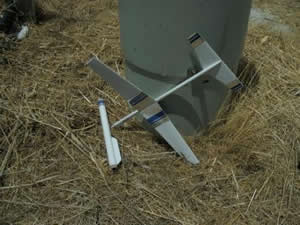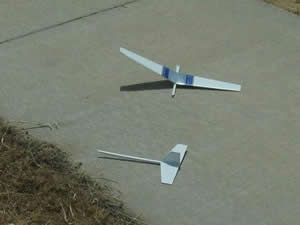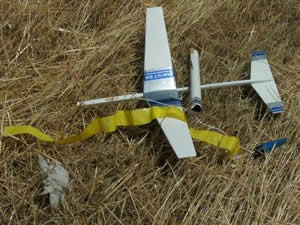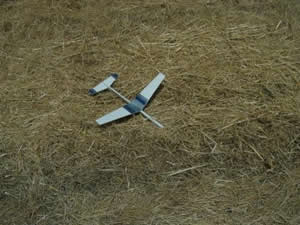| Construction Rating: | starstarstar_borderstar_borderstar_border |
| Flight Rating: | starstarstar_borderstar_borderstar_border |
| Overall Rating: | starstarstar_borderstar_borderstar_border |
| Published: | 2010-06-28 |
| Diameter: | 0.79 inches |
| Length: | 20.00 inches |
| Manufacturer: | Quest  |
| Skill Level: | 3 |
| Style: | Glider |

Brief:
The Flat Cat is a classic boost glider with a streamer-recovery pod.
Construction:
Parts List:
- Launch lug
- 18mm motor tube
- 8.5 inch body tube
- Thrust Ring
- Plastic nose cone and base
- 24inch streamer and gripper tab
- Balsa fuselage
- Balsa pylon
- Three sheets of die-cut parts
- Motor mount
- Trim clay
- Elastic shock cord
- Kevlar® cord
- Chrome peel-and-stick decals
- Instructions
Jim:
I have built several boost gliders and had wanted to try the Flat cat since
it is larger than average and it looked fairly easy to build.
Edie:
I have never built a boost glider and am a novice builder (3 completed
rockets-2 in process). It was my intention to build this rocket, following the instructions to the letter and with
little or no help. This is
 a skill
level 3 rocket and at first glance looked like a complicated build to me.
a skill
level 3 rocket and at first glance looked like a complicated build to me.
Jim:
There were several things I didn’t like about the quality of the
components. The balsa was not consistent. One wing was very soft, almost crumbly balsa and the other was very hard.
Also this is an old kit, I think the original was made by MPC in the 70’s, and it has die-cut balsa parts. The die
cutting, combined with the soft balsa made for some crushed parts that required a lot of filling. The second problem I
had was with the way Quest does their motor mounts. You have to shove the yellow 18mm motor tube into the 20mm body
tube and stop before going too far. I have trouble getting enough glue on the part so that it will slide without
seizing halfway in, yet not slide past the mark. This one went in too far and seized up so that I couldn’t get it
in the right depth. Still worked, but I don’t like that system.


The next thing I did not like was the way the pod hook is constructed. The balsa ends up with the grain running parallel to the body (Since you cut the piece from the fuselage) and I was not sure it would be strong enough not to split during boost, or at deployment – this proved to be a big problem later. One last problem I had was with the wing mount. The instructions have you glue the wings together at the center, then sand a half-inch-wide flat spot on the bottom of the joint to glue to the body. This would require shaving off half the joint thickness. I thought this would weaken the joint too much, so I cut a groove in the body to accommodate the wing instead. Otherwise the kit went together like any other boost glider.
Edie:
For the most part I agree with Jim here. The balsa was very inconsistent,
not only in thickness but in quality. The die cutting on some parts was incomplete. Some sections were sturdy and clean
cut while others were chippy and weak. Balsa thickness did not match on the wings or the tail pieces.
The pod hook being cut from the fuselage causes a couple of problems. One is as Jim stated in his review, the second is that the thickness of the hook leaves a very thin wall of balsa as a compartment for the hook to rest in. Once the pod disengages from the glider, that empty compartment is a weak spot in the nose. If the nose of the glider takes any impact at all on landing, it is not strong enough to take it.
A note about the instructions. For me, the assembly order seemed to complicate things. There is a definite benefit to reading through ALL the instructions before you start (maybe a novice issue?). The illustrations and BOLD TYPE warnings saved me.
Finishing:
Jim:
I had thought of leaving my Flat Cat unfinished, but
the balsa on one wing was so soft and crushed by the die-cutting that I didn’t think that would work, so I used
two coats of Elmer’s Carpenter’s Wood Filler thinned with water to smooth and strengthen the wood parts. I
then was able to finish it with one coat of white primer and one coat of gloss white. I painted the nosecone dark blue
to match the blue stripes on the decals.
The hardest part I had with finishing was applying the foil decals. I just could not get them on straight or meeting properly at the wing root. Because these decals are more than just decorative, but actually protect the wing from the engine exhaust, I just decided to overlap them in the center, since I could not make the edges meet otherwise.
After all the decals were done I went to install the streamer and could not find the gripper tab. Instead I used peel and stick reinforcement rings for binder pages and a hole punch to make my own.
Edie:
I also found wood filler a necessary part of this build. If I had finished
this rocket as the instructions recommended it would have been very difficult to paint or balance and I am certain at
least one wing would have broken apart due to the poor quality of the balsa.
I found the wings and rudder to be challenging, mainly because I chose to air foil both (the instructions leave this step optional). Precise sanding is key, otherwise nothing goes together correctly. Again, the illustrations and BOLD TYPE saved me.
Construction Rating: 2 out of 5


Flight:
Jim:
I went to trim the glider and found that the balance point
for a level glide was about an inch behind the wing root, which seemed very weird, but worked. Unfortunately, there
were very limited opportunities to fly these rockets before the review deadline and we had to settle for a fairly windy
day. Winds were about 5 to 10mph. I used a B6-4 for the first flight and packed the streamer with 4 squares
of wadding. The boost was fair with the rocket arcing over into the wind so that it was almost horizontal at apogee
around 200’ up. The delay was too long and it was all ready coming down when it ejected. The pod failed to
separate at ejection, and the whole glider-streamer-booster combo tumbled to the ground where it busted the pod hook
right along the parallel grain and knocked the tail off.
about 5 to 10mph. I used a B6-4 for the first flight and packed the streamer with 4 squares
of wadding. The boost was fair with the rocket arcing over into the wind so that it was almost horizontal at apogee
around 200’ up. The delay was too long and it was all ready coming down when it ejected. The pod failed to
separate at ejection, and the whole glider-streamer-booster combo tumbled to the ground where it busted the pod hook
right along the parallel grain and knocked the tail off.
I brought it all back to the pad and got out the 5 minute epoxy to glue it all back together while Edie made her first flight.
Edie:
Same engine- B-64, same four squares of wadding. The rocket took off
perfectly, straight up,arched over and went into a vertical dive that it never pulled out of. Impacted the sidewalk,
head on. No deployment, no streamer and no idea why it behaved this way. Glider flew very well in glide tests. After
“landing” I recovered 5 pieces. The fuselage snapped in two places, mid way between the tail and the wings,
and at the pod hook compartment. The walls of that compartment and the nose of the glider were crushed on impact. The
wing tip of one wing also snapped off along the line of the grain. Far too much to repair at the launch site.




Jim:
After my glue dried, I sanded the edges off the pod mount to make it detach
easier and tried again. The up part was pretty much the same but I did get separation of the pod at ejection this time.
Unfortunately the shock cord tangled around the glider and the whole thing tumble recovered again. Upon landing, I
found that the pod hook had again broken along the grain right above the glue joint. So it was back to the epoxy again.
Jim:
on my third attempt I again used a B6-4 and it went up the same, turning
into the wind. This time I got a clean ejection and the glider did a loop, then several swooping stalls to land
undamaged. The pod, however, fell tail-first and fast, hitting the ground on a paved road. The impact was so hard it
bent to motor hook flat and caused a compression wrinkle in the body tube. It is still flyable, but I think it needs a
chute if it’s going to last very long.


Recovery:
Jim:
The recovery has a lot of cons for me. The glider does
not balance easily, and because the one wing was so light, it doesn’t balance from side-to-side well. The pod
mount breaks too easily because the grain direction is in line with the sheer force. I also think the pod is too heavy
for a streamer, and needs a parachute for recovery.
Edie:
My recovery was of pieces. No deployment, no gliding, no streamer.
Literally, Up....down....repair.
I think I have heard it called...”re-kitting”?
Flight Rating: 2 out of 5
Summary:
Jim:
I really wanted to like this rocket, but was disappointed
in it overall. I think the kit is outdated, and needs an overhaul. If it had laser-cut parts, a parachute, and a better
design of the pod-hook, I think it could be a great kit. As it is, there are better glider kits on the market. This is
a classic, but, unfortunately, a dated classic.
Edie:
I think this rocket taught me a lot about finishing and balancing detail.
The build was not as complicated as I first thought and the instructions turned out to be very well done, although in
an odd order. I enjoyed building it and think it “looks” cool. Sadly, it didn't fly well for me.
I think the biggest problem is the quality of the material and the pod hook seems like poor design. Poor balsa consistency, incomplete die cuts and a weakened nose/fuselage.
Overall Rating: 2 out of 5
Other:
This is a challenging model, and not necessarily for the right reasons. With better balsa and a
little tweaking, it could be a real treasure.
Other Reviews
- Quest Flat Cat By Hank Helmen (November 13, 2008)
Brief: This is a boost glider rocket with streamer recovery for the booster. Construction: The Quest Flat Cat boost glider includes an 18mm body tube for the booster as well as an engine mount kit. There are die cut balsa wings and fins. Also included in the kit is a 24" plastic recovery streamer, shock cord, plastic nose cone and decals. The instructions were easy to ...
- Quest Flat Cat By Chris Taylor Jr. (November 5, 2008)
Packaging: Plastic bag with cardboard display picture. The Parts: Lots of very nice, high-quality, thick balsa wood. No skimpy stuff here. This is going to be one tough glider! Standard Pop-pod Glider. Basically a short, finless rocket that attaches the nose of the glider with a one-way hook, I. e. go up and it hooks, go back and it falls off. The motor's ejection ...
- Quest Flat Cat By Matt Gillard (December 30, 2007)
Brief: A pop pod glider for B and C motors. The design is tried and tested and there are two levels of finish: one simple one that is a quick glue together without any airfoils, which is where the flat part of its name comes from, and a second where there is a great deal of sanding involved. Quest puts this rocket at a skill level three which is about right for the airfoil version ...
- Quest Flat Cat By Mitch Marchi (December 14, 2007)
Brief: Low power rocket booster with streamer recovery and glider flight recovery. Construction: Rocket booster is basically an 18mm minimum diameter rocket with a balsa "hook" assembly on it instead of fins. Glider is comprised completely of balsa. Wings and stabilizer are 1/8", fuselage is 1/4" x 1/2". The instructions were good, except that ...
 |
 |
Flights
 |
 |
R.J. (September 1, 2000)
B.M. (October 1, 2000)
(December 1, 2000)
HWH (November 9, 2008)
 |
 |
B.M. (August 1, 2000)